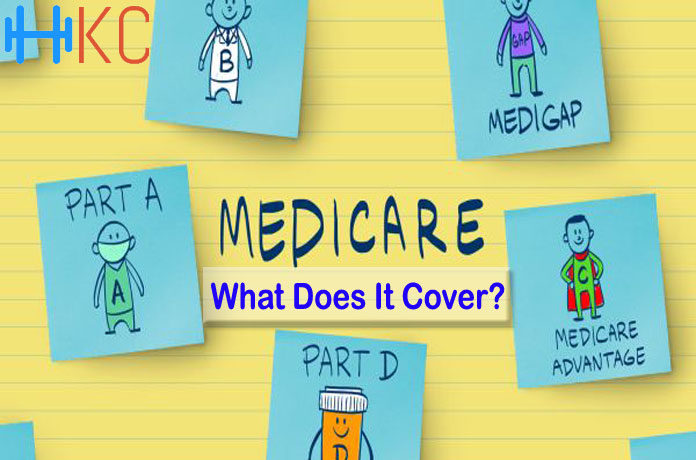Medicare is a program that most Americans will be part of though what it covers, often remains confusing to beneficiaries. In this article, we will break down the four parts of Original Medicare and what they cover.
Part A
Medicare Part A can be summed up as hospital insurance that assists you with inpatient care and skilled nursing facility stays. It also helps with things like hospice and home health care. As a rule of thumb, you can think of Part A as Medicare coverage for room and board in a hospital or inpatient facility.
Let’s take a closer look at exactly what your Part A will cover. Be aware that as a Medicare beneficiary, you will share in the cost of covered items as well in the forms of deductibles, copayments, and coinsurance.
Inpatient Hospital Care
Medicare Part A covers your hospital stay and the services while you are. This includes semi-private rooms, meals, general nursing, drugs administered during your stay, and other necessary supplies.
Skilled Nursing Facility Care
Under certain conditions, your stay in a skilled nursing facility will be covered by Part A. These facilities provide a high level of care, typically for rehabilitation purposes. Medicare Part A will cover up to 100 days in a skilled nursing facility.
Hospice
If you have been diagnosed with a terminal illness that reduces your life expectancy to six months or less, Medicare will cover your hospice care. Most often, hospice careis given in your home and covered by Part A. In some cases, it could also be covered in an inpatient hospice facility.The specific services covered while on hospice generally depend upon your terminal illness and the services necessary to your care. However, beyond just medical care, your benefits may even include chaplain services, grief counseling for your family and the aid of a social worker.
Home Health Care
The coverage you receive from Part A for home health care is usually on a short-term basis, for up to 14 days after you leave inpatient care. These “intermittent” services are most often skilled nursing, physical therapy, or occupational therapy that take place in your home instead of a facility.
Enrolling in Part A
If you currently receive Social Security or Railroad Retirement benefits, you will be automatically enrolled in Part A. This will happen on the first day of the month of your 65th birthday. For those who are not receiving Social Security, you are not automatically enrolled. You must apply online at Medicare.gov or through your local Social Security office.
Part B
Part B can be thought of as your outpatient coverage. For example, it covers your visits to the doctor, preventive care, lab tests, outpatient surgeries and more. Below, we will expand on the different services included under Part B.
Each year you will have to pay a Part B deductible. The cost is set by Medicare and changes from year to year. Once the deductible is satisfied, Medicare pays for 80%of your Part B services.
Here’s are some of the other services you can expect Part B to cover you for:
Ambulance services and Emergency Care
Part B will cover ambulance services to or from a hospital or skilled nursing facility (SNF). Be aware that Medicare will only help to pay for ambulance services when other transportation could jeopardize your health. Emergency care is also covered under Part B unless you are admitted to the hospital.
Durable medical equipment (DME)
Durable medical equipment (DME) that is medically necessary and prescribed for use in your home, is covered by Medicare. Only your doctor can prescribe medical equipment for you. You can find a detailed list of DME approved by Medicare here.
Mental health
Part B covers mental health services in outpatient settings such as a doctor’s office or community mental health facility. Typically, these services are counseling or therapy sessions though drug abuse treatment also falls into this category. The provider must accept assignment for Medicare to cover the service.
Other Outpatient Services
Medically necessary diagnostic and treatment services that you receive in an outpatient hospital setting are covered by Medicare. Some of these services include:
- Services in an outpatient clinic (including same-day surgery)
- Laboratory tests billed by the hospital
- Mental health care in a partial hospitalization program
- X-rays and radiology services billed by the hospital
- Medical supplies, like splints and casts or diabetes monitoring supplies
- Preventive and screening services
Getting a second opinion before surgery
If your doctor says you need surgery to diagnose or treat a health issue, Medicare will cover your visit to another doctor to get a second opinion.
Limited outpatient prescription drugs
Part B generally does not cover prescription drugs that are used at home. You will need a Part D drug plan for those. With that said, some drugs that you wouldn’t usually give to yourself may be covered by Part B. Injectable or infused drugs given by your doctor in a clinical setting are an example.
Enrolling in Part B
Part B is a critical part of your healthcare coverage when Medicare is primary for you. With that said, it is important you get enrolled at the right time.
Unless you are already receiving Social Security benefits prior to turning 65, you are not automatically enrolled. You can sign up for Medicare online through the Medicare.gov website or you can visit your local Social Security office to get enrolled.
Part C
Part C of Medicare is more often called Medicare Advantage (MA). Medicare Advantage is a combination of Part A, Part B, and (usually) Part D together as one plan. When you enroll in a Medicare Advantage plan, you will have one ID card that you use at the hospital, doctor’s office and pharmacy. The plan will usually have a network of providers that you will seek your care from.
Each Medicare Advantage plan will have its own premiums, copays, network, pharmacy network and drug formulary. However, you can count on it covering all the same services that Original Medicare Part A and B provide.
Enrolling in Part C
You can enroll in a Medicare Advantage plan during your initial enrollment period when you first enroll in Medicare Part B. You are also able to change this plan during the annual election period each fall , which runs from October 15 – December 7th.
Part D
Part D of Medicare covers outpatient prescription medications through private insurance plans. These plans have a contract with Medicare. You can enroll in either a stand-alone prescription drug plan (PDP) or one that is inside of a Medicare Advantage prescription drug plan (MA-PD).
Each Part D drug plan has what is called a formulary. The formulary is the list of drugs covered by the specific PDP or MA-PD. Most of these plans have tiers on their formularies which put drugs into different price categories in accordance with their tier.
Most of the time, a drug that appears in a lower tier will cost you less than a drug that is assigned to a higher tier. If your prescriber finds it necessary for you to have a drug in a higher tier, they can ask for an exception.
Enrolling in Part D
Unlike Part A and Part B of Medicare, Part D is a voluntary program. Each insurance company that offers a Part D plan decides which drugs it will cover and what they will cost.
Part D enrollment and the service area of your plan is dependent upon where you live. You can enroll in Part D directly with a Medicare Part D insurance provider or through an agent that specializes in Medicare products. By working with an agent, you will have back-end support if you run into any issues, such as prior authorization requirements or drug exceptions.
You can also enroll in Medicare Part D via Medicare’s website or by calling Medicare at 1-800-MEDICARE.























